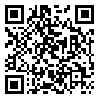Wed, Dec 10, 2025
[Archive]
Volume 16, Issue 2 (June 2020)
IJEEE 2020, 16(2): 137-145 |
Back to browse issues page
Download citation:
BibTeX | RIS | EndNote | Medlars | ProCite | Reference Manager | RefWorks
Send citation to:



BibTeX | RIS | EndNote | Medlars | ProCite | Reference Manager | RefWorks
Send citation to:
Monemizadeh M, Fehri H, Abed Hodtani G, Hajizadeh S. Capacity Bounds and High-SNR Capacity of the Additive Exponential Noise Channel With Additive Exponential Interference. IJEEE 2020; 16 (2) :137-145
URL: http://ijeee.iust.ac.ir/article-1-1335-en.html
URL: http://ijeee.iust.ac.ir/article-1-1335-en.html
Abstract: (4415 Views)
Communication in the presence of a priori known interference at the encoder has gained great interest because of its many practical applications. In this paper, additive exponential noise channel with additive exponential interference (AENC-AEI) known non-causally at the transmitter is introduced as a new variant of such communication scenarios. First, it is shown that the additive Gaussian channel with a priori known interference at the encoder when the transmitter suffers from a fast-varying phase noise can be modeled by the AENC-AEI. Then, capacity bounds for this channel under a non-negativity constraint as well as a mean value constraint on input are derived. Finally, it is shown both analytically and numerically that the upper and lower bounds coincide at high signal to noise ratios (SNRs), and therefore, the capacity of the AENC-AEI at high SNRs is obtained. Interestingly, this high SNR-capacity has a simple closed-form expression and is independent of the interference mean, analogous to its Gaussian counterpart.
Full-Text [PDF 872 kb]
(1446 Downloads)
- We introduced the additive exponential noise (AEN) channel afflicted by an extra additive exponential interference (AEI) in which full knowledge of the additive interference is given to the transmitter.
- The AENC-AEI is in fact an exponential version of the Costa’s dirty paper channel.
- The AENC-AEI is a natural model for the complex-valued AWGNC-AWI when the transmitted signal suffers from a fast-varying phase noise and the receiver has to use a non-coherent detector to recover transmitted information.
- Interestingly, the high SNR-capacity of the AENC-AEI (obtained in this paper) is independent of the interference mean and has a simple closed-form expression, analogous to its Gaussian counterpart.
Type of Study: Research Paper |
Subject:
Communication Systems
Received: 2018/09/07 | Revised: 2019/08/06 | Accepted: 2019/08/10
Received: 2018/09/07 | Revised: 2019/08/06 | Accepted: 2019/08/10
| Rights and permissions | |
 |
This work is licensed under a Creative Commons Attribution-NonCommercial 4.0 International License. |









